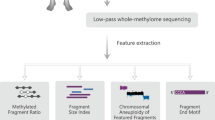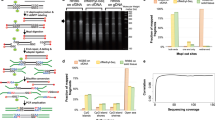Abstract
Analysis of abnormally methylated genes is increasingly important in basic research and in the development of cancer biomarkers1,2. We have developed methyl-BEAMing technology to enable absolute quantification of the number of methylated molecules in a sample. Individual DNA fragments are amplified and analyzed either by flow cytometry3 or next-generation sequencing. We demonstrate enumeration of as few as one methylated molecule in ∼5,000 unmethylated molecules in DNA from plasma or fecal samples. Using methylated vimentin as a biomarker in plasma samples, methyl-BEAMing detected 59% of cancer cases. In early-stage colorectal cancers, this sensitivity was four times more than that obtained by assaying serum-carcinoembryonic antigen (CEA). With stool samples, methyl-BEAMing detected 41% of cancers and 45% of advanced adenomas. In addition to diagnostic and prognostic applications, this digital quantification of rare methylation events should be applicable to preclinical assessment of new epigenetic biomarkers and quantitative analyses in epigenetic research.
This is a preview of subscription content, access via your institution
Access options
Subscribe to this journal
Receive 12 print issues and online access
$209.00 per year
only $17.42 per issue
Buy this article
- Purchase on Springer Link
- Instant access to full article PDF
Prices may be subject to local taxes which are calculated during checkout



Similar content being viewed by others
References
Sidransky, D. Emerging molecular markers of cancer. Nat. Rev. Cancer 2, 210–219 (2002).
Fleischhacker, M. & Schmidt, B. Circulating nucleic acids (CNAs) and cancer–a survey. Biochim. Biophys. Acta 1775, 181–232 (2007).
Dressman, D., Yan, H., Traverso, G., Kinzler, K.W. & Vogelstein, B. Transforming single DNA molecules into fluorescent magnetic particles for detection and enumeration of genetic variations. Proc. Natl. Acad. Sci. USA 100, 8817–8822 (2003).
Feinberg, A.P. & Tycko, B. The history of cancer epigenetics. Nat. Rev. Cancer 4, 143–153 (2004).
Jones, P.A. & Baylin, S.B. The epigenomics of cancer. Cell 128, 683–692 (2007).
Laird, P.W. The power and the promise of DNA methylation markers. Nat. Rev. Cancer 3, 253–266 (2003).
Diehl, F. et al. Detection and quantification of mutations in the plasma of patients with colorectal tumors. Proc. Natl. Acad. Sci. USA 102, 16368–16373 (2005).
Diehl, F. et al. Analysis of mutations in DNA isolated from plasma and stool of colorectal cancer patients. Gastroenterology 135, 489–498 (2008).
Bailey, V.J. et al. MS-qFRET: a quantum dot-based method for analysis of DNA methylation. Genome Res. 19, 1455–1461 (2009).
Hayatsu, H. The bisulfite genomic sequencing used in the analysis of epigenetic states, a technique in the emerging environmental genotoxicology research. Mutat. Res. 659, 77–82 (2008).
Herman, J.G., Graff, J.R., Myohanen, S., Nelkin, B.D. & Baylin, S.B. Methylation-specific PCR: a novel PCR assay for methylation status of CpG islands. Proc. Natl. Acad. Sci. USA 93, 9821–9826 (1996).
Xiong, Z. & Laird, P.W. COBRA: a sensitive and quantitative DNA methylation assay. Nucleic Acids Res. 25, 2532–2534 (1997).
Gonzalgo, M.L. & Jones, P.A. Rapid quantitation of methylation differences at specific sites using methylation-sensitive single nucleotide primer extension (Ms-SNuPE). Nucleic Acids Res. 25, 2529–2531 (1997).
Lo, Y.M. et al. Quantitative analysis of aberrant p16 methylation using real-time quantitative methylation-specific polymerase chain reaction. Cancer Res. 59, 3899–3903 (1999).
Eads, C.A. et al. MethyLight: a high-throughput assay to measure DNA methylation. Nucleic Acids Res. 28, E32 (2000).
Vogelstein, B. & Kinzler, K.W. Digital PCR. Proc. Natl. Acad. Sci. USA 96, 9236–9241 (1999).
Grunau, C., Clark, S.J. & Rosenthal, A. Bisulfite genomic sequencing: systematic investigation of critical experimental parameters. Nucleic Acids Res. 29, E65 (2001).
Okamoto, A. Chemical approach toward efficient DNA methylation analysis. Org. Biomol. Chem. 7, 21–26 (2009).
Zou, H. et al. Highly methylated genes in colorectal neoplasia: implications for screening. Cancer Epidemiol. Biomarkers Prev. 16, 2686–2696 (2007).
Chen, W.D. et al. Detection in fecal DNA of colon cancer-specific methylation of the nonexpressed vimentin gene. J. Natl. Cancer Inst. 97, 1124–1132 (2005).
Jahr, S. et al. DNA fragments in the blood plasma of cancer patients: quantitations and evidence for their origin from apoptotic and necrotic cells. Cancer Res. 61, 1659–1665 (2001).
Diehl, F. et al. Circulating mutant DNA to assess tumor dynamics. Nat. Med. 14, 985–990 (2008).
Hundt, S., Haug, U. & Brenner, H. Comparative evaluation of immunochemical fecal occult blood tests for colorectal adenoma detection. Ann. Intern. Med. 150, 162–169 (2009).
Lieberman, D.A. Screening for colorectal cancer. Clin. Cornerstone 4, 1–10 (2002).
Kahi, C.J., Rex, D.K. & Imperiale, T.F. Screening, surveillance, and primary prevention for colorectal cancer: a review of the recent literature. Gastroenterology 135, 380–399 (2008).
Humphrey, L.L., Helfand, M., Chan, B.K. & Woolf, S.H. Breast cancer screening: a summary of the evidence for the US Preventive Services Task Force. Ann. Intern. Med. 137, 347–360 (2002).
Kent Moore, J., Smith, J.A., Whitney, D.H., Durkee, K.H. & Shuber, A.P. An electrophoretic capture method for efficient recovery of rare sequences from heterogeneous DNA. Biotechniques 44, 363–374 (2008).
Rago, C. et al. Serial assessment of human tumor burdens in mice by the analysis of circulating DNA. Cancer Res. 67, 9364–9370 (2007).
Warnecke, P.M. et al. Detection and measurement of PCR bias in quantitative methylation analysis of bisulphite-treated DNA. Nucleic Acids Res. 25, 4422–4426 (1997).
Diehl, F. et al. BEAMing: single-molecule PCR on microparticles in water-in-oil emulsions. Nat. Methods 3, 551–559 (2006).
Acknowledgements
We thank B. Berger for helpful discussions; D. Edelstein for the help with plasma collection; and M. Whalen and L. Kasturi for expert technical assistance. This work was supported by the Virginia and D.K. Ludwig Fund for Cancer Research; the Miracle Foundation; the Edelstein Fund; the US National Colorectal Cancer Research Alliance; The US National Institutes of Health grants CA43460,CA62924 and CA120237; The Danish Cancer Society; The Danish Research Council; and The Institute of Experimental Clinical Research, Aarhus University.
Author information
Authors and Affiliations
Contributions
M.L., S.D.M., S.N.G., K.W.K. and B.V. designed the project. M.L. developed the methyl-BEAMing assay and performed the experiments on plasma and fecal DNA. N.P., M.L. and Y.H. performed the Solexa sequencing experiments. H.M. performed the MSP assay. K.D. purified fecal DNA. S.N.G. provided statistical analysis. H.J., L.A.D., N.C.B., S.L., N.A. and K.S. collected clinical samples. W.-d.C., S.Z, V.E.V., F.D. and B.L. made intellectual contributions to the project. B.V., M.L. and S.D.M. wrote the manuscript.
Corresponding author
Ethics declarations
Competing interests
Technology for digital quantification of methylated DNA is the subject of a patent application from Johns Hopkins and Case Western Universities that include S.D.M., M.L., W.D.C., B.V. and K.W.K. as inventors. Under agreements between the Johns Hopkins University, Genzyme, Exact Sciences, Beckman, Inostics, and Invitrogen, K.W.K., B.V., M.L., and F.D. are entitled to a share of the royalties received by the University on sales of products related to BEAMing. Under agreements between Case Western University and Exact Sciences, S.D.M. and W.D.C. are entitled to a share of the royalties received on sales of products related to methylated vimentin DNA. Johns Hopkins University, K.W.K. and B.V. own stock in Genzyme and K.W.K., B.V., N.P., F.D. and L.D. own stock in Inostics, both of which are subject to certain restrictions under Johns Hopkins University policy. The terms of these arrangements are being managed by the universities in accordance with their conflict of interest policies.
Supplementary information
Supplementary Text and Figures
Supplementary Figures 1–6 and Supplementary Tables 1–5 (PDF 846 kb)
Rights and permissions
About this article
Cite this article
Li, M., Chen, Wd., Papadopoulos, N. et al. Sensitive digital quantification of DNA methylation in clinical samples. Nat Biotechnol 27, 858–863 (2009). https://doi.org/10.1038/nbt.1559
Received:
Accepted:
Published:
Issue Date:
DOI: https://doi.org/10.1038/nbt.1559
This article is cited by
-
Genome-wide DNA methylation profiling in differentiating Crohn’s disease from intestinal tuberculosis
Genes & Genomics (2022)
-
Methylated circulating tumor DNA as a biomarker for colorectal cancer diagnosis, prognosis, and prediction
Clinical Epigenetics (2021)
-
Circulating tumor DNA methylation marker MYO1-G for diagnosis and monitoring of colorectal cancer
Clinical Epigenetics (2021)
-
DNA methylation markers detected in blood, stool, urine, and tissue in colorectal cancer: a systematic review of paired samples
International Journal of Colorectal Disease (2021)
-
Liquid Biopsy for Prognosis and Treatment in Metastatic Colorectal Cancer: Circulating Tumor Cells vs Circulating Tumor DNA
Targeted Oncology (2021)



